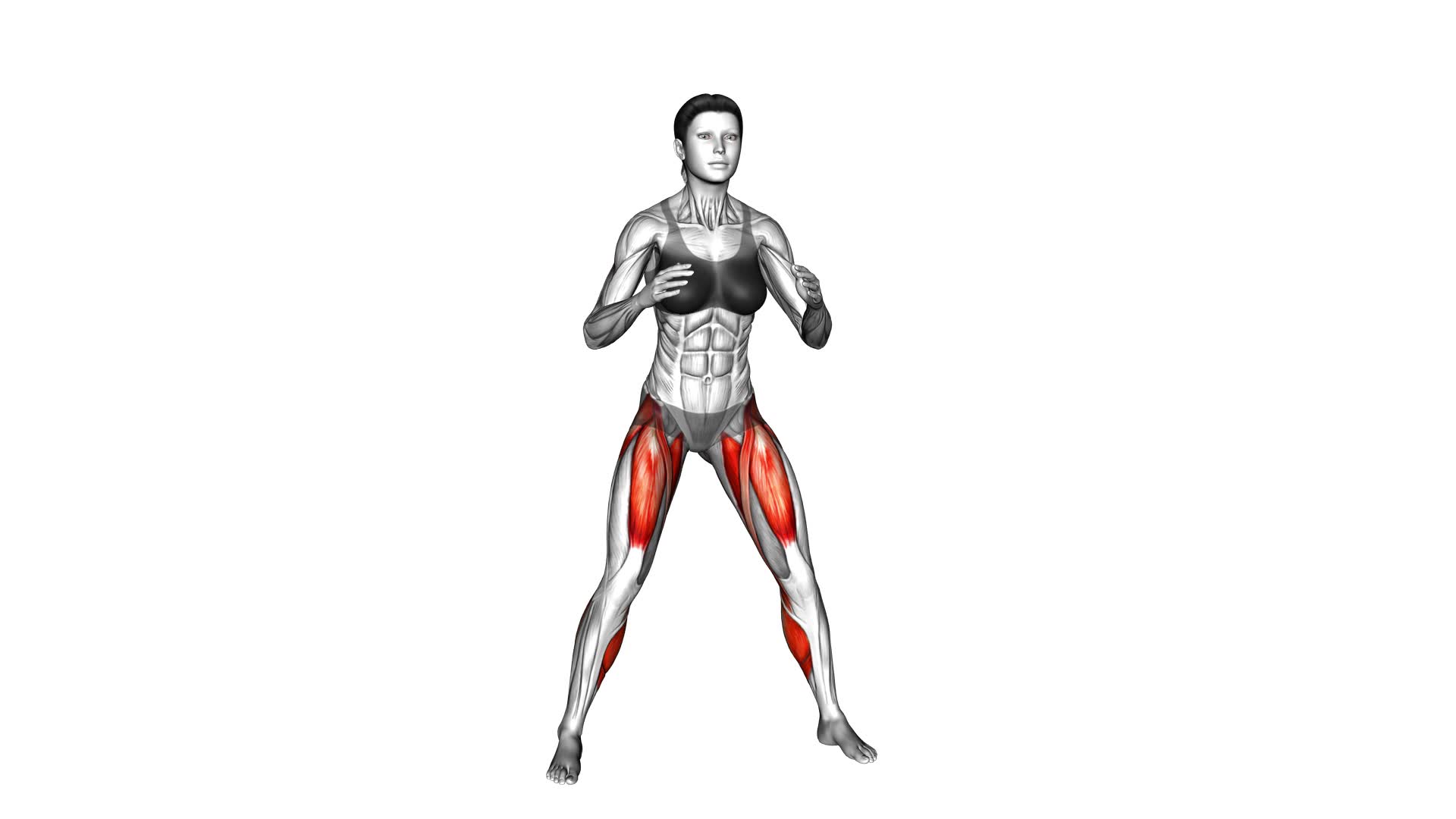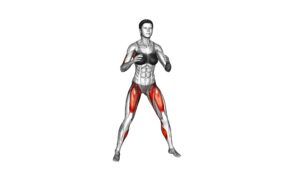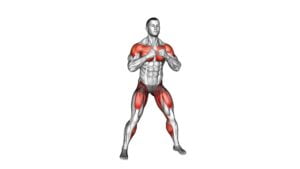Alternating Hamstring Curl Kick (female) – Video Exercise Guide & Tips

Are you looking to strengthen your hamstrings and tone your legs? Look no further than the alternating hamstring curl kick! This exercise targets your hamstrings, glutes, and calves, giving you a great lower body workout.
Watch This Exercise Video
In this video exercise guide, we'll show you the proper form and technique to get the most out of this move. Whether you're a beginner or a seasoned fitness enthusiast, we've got modifications and tips to help you maximize your results.
Let's get started!
Key Takeaways
- Alternating Hamstring Curl Kick targets hamstrings, glutes, and calves.
- This exercise strengthens and tones the lower body.
- It improves balance, coordination, and flexibility.
- Modifications can be made for beginners to progress safely and effectively.
Benefits of Alternating Hamstring Curl Kick
You can experience numerous benefits from incorporating the alternating hamstring curl kick into your workout routine. This exercise primarily targets your hamstrings, glutes, and calf muscles, helping to strengthen and tone these areas. By performing this exercise regularly, you can improve your overall lower body strength and stability.
One of the key benefits of the alternating hamstring curl kick is its ability to enhance your balance and coordination. As you kick one leg back while contracting your hamstring, you engage your core muscles to maintain stability. This not only improves your balance but also helps to prevent injuries caused by instability.
In addition to enhancing balance, the alternating hamstring curl kick also helps to improve your flexibility. This exercise requires a full range of motion in your hips and knees, allowing your muscles to stretch and become more flexible over time. Incorporating proper breathing technique into your routine can further enhance the benefits of this exercise by promoting relaxation and improving your focus.
For advanced practitioners, there are variations of the alternating hamstring curl kick that can provide an additional challenge. These variations may include adding ankle weights or performing the exercise on an unstable surface, such as a Bosu ball. These modifications can help to further strengthen your muscles and improve your balance and coordination.
Proper Form and Technique
To ensure proper form and technique for the alternating hamstring curl kick, focus on engaging your core muscles and maintaining stability throughout the exercise. This will help you maximize the benefits of the workout and reduce the risk of injury. Here are some important tips to keep in mind:
- Start by standing tall with your feet hip-width apart and your arms extended in front of you.
- As you lift one leg behind you, keep your knee slightly bent and your foot flexed.
- Engage your core and squeeze your glutes to lift your leg as high as you comfortably can.
- Lower your leg back down with control, keeping your core engaged and your standing leg stable.
- Repeat the movement on the other side, alternating legs with each repetition.
Flexibility is crucial for performing the alternating hamstring curl kick effectively. Make sure to warm up before the exercise and incorporate stretching exercises to improve your flexibility. For those at an advanced level, you can add variations like using ankle weights or resistance bands to increase the intensity of the exercise.
Now that you understand the proper form and technique for the alternating hamstring curl kick, let's move on to modifications for beginners.
Modifications for Beginners
For beginners, a helpful modification to try for the alternating hamstring curl kick is to perform the exercise at a slower pace. This modification allows you to focus on proper form and technique, while also reducing the risk of injury. By slowing down the movement, you can better engage your hamstring muscles and improve your balance and stability. As you become more comfortable with the exercise, you can gradually increase the speed to challenge yourself and further enhance your strength and flexibility.
Another modification for beginners is to decrease the range of motion. Instead of fully extending your leg during the kick, you can start with smaller movements and gradually work your way up to a full range of motion. This modification helps build strength in your hamstring muscles without putting too much strain on your joints.
It is important to remember that modifications aren't a sign of weakness, but rather a way to progress safely and effectively. As you continue to practice and improve, you can gradually increase the difficulty of the exercise by adding weights or performing the exercise on an unstable surface.
Common Mistakes to Avoid
When performing the alternating hamstring curl kick exercise, it's important to be aware of common mistakes to avoid. Incorrect form can lead to potential dangers such as muscle strain or injury.
Overextending the knee joint can also put unnecessary stress on the joint.
Additionally, not warming up properly before starting the exercise can increase the risk of injury.
It's crucial to pay attention to these points and ensure correct form, proper knee alignment, and a thorough warm-up to maximize the effectiveness and safety of the exercise.
Incorrect Form Dangers
If you don't use proper form while performing the alternating hamstring curl kick, you risk injuring yourself. Here are some dangers of incorrect form and tips to prevent injuries:
- Loss of balance: Failing to maintain proper balance during the exercise can lead to falls and sprains. Ensure that you engage your core muscles and stay centered throughout the movement.
- Strained muscles: Using momentum instead of controlled movements can strain your muscles, particularly the hamstrings. Focus on a slow and controlled motion to avoid overexertion.
- Back pain: Incorrect form can put unnecessary strain on your lower back, leading to pain and discomfort. Keep your back straight and avoid arching or rounding it during the exercise.
- Knee injuries: Hyperextending or locking your knees during the movement can result in knee injuries. Always keep a slight bend in your knees to protect them.
- Lack of results: Incorrect form can diminish the effectiveness of the exercise and prevent you from achieving your desired results. Ensure you're using the correct technique to maximize the benefits.
Overextending Knee Joint
To avoid overextending your knee joint and risking injury, it's important to maintain proper form during the alternating hamstring curl kick exercise. Overextending the knee joint can lead to overuse injuries, such as strains or tendonitis.
When performing this exercise, be mindful of your knee alignment and make sure not to hyperextend or lock your knees. Keep a slight bend in your knees throughout the movement to protect the joint.
Additionally, focus on engaging your hamstring muscles and maintaining control as you kick your leg back. Strengthening exercises for the hamstrings, such as hamstring curls, can also help prevent overuse injuries and improve overall knee stability.
Remember to listen to your body and stop if you experience any pain or discomfort during the exercise.
Lack of Warm-Up
To prevent potential injuries and optimize your performance, it's crucial that you avoid the common mistake of skipping a warm-up before engaging in the alternating hamstring curl kick exercise. A proper warm-up prepares your body for the physical demands of the workout ahead.
Here are some warm-up techniques and the importance of stretching:
- Dynamic stretching: Perform movements that mimic the exercise you're about to do, like leg swings or walking lunges.
- Foam rolling: Use a foam roller to release tension in your muscles and improve flexibility.
- Joint mobility exercises: Rotate your ankles, knees, and hips to increase blood flow and range of motion.
- Cardiovascular exercise: Get your heart rate up with a few minutes of light jogging or jumping jacks.
- Activation exercises: Engage specific muscles with exercises like glute bridges or hip circles.
Tips for Maximizing Results
To maximize your results with the alternating hamstring curl kick exercise, it's important to focus on proper form. This means engaging your core, keeping your back straight, and maintaining control throughout the movement.
Additionally, consistency is key for seeing the best results. Make sure to incorporate this exercise into your workout routine regularly to strengthen and tone your hamstrings effectively.
Proper Form Importance
Achieving proper form is crucial for maximizing your results during the Alternating Hamstring Curl Kick exercise. By maintaining the correct form, you not only optimize the effectiveness of the exercise but also reduce the risk of injury.
Here are some tips to help you achieve proper form and get the most out of your workout:
- Stretch before starting the exercise: Stretching is important to warm up your muscles and increase flexibility, which can help prevent injuries.
- Focus on your core: Engage your core muscles throughout the exercise to provide stability and support for your body.
- Keep your back straight: Maintain a neutral spine position to avoid straining your lower back.
- Control the movement: Move in a controlled manner, avoiding any jerking or swinging motions.
- Use the appropriate weight: Choose a weight that challenges you but still allows you to maintain proper form.
Consistency for Best Results
Maintaining consistency in your workout routine is key to achieving the best results and maximizing the effectiveness of the Alternating Hamstring Curl Kick exercise.
Consistency is crucial because it allows your body to adapt and progress over time. By regularly performing this exercise, you'll build strength in your hamstrings, glutes, and core muscles.
To maximize consistency, it's important to establish a schedule that works for you and stick to it. Avoiding plateaus is another benefit of maintaining consistency.
Plateaus occur when your body becomes accustomed to a certain level of exercise, and progress slows down or stops. By consistently challenging yourself and gradually increasing the intensity or resistance of the exercise, you can avoid plateaus and continue making progress towards your fitness goals.
Incorporating Alternating Hamstring Curl Kick Into Your Workout Routine
To effectively incorporate the alternating hamstring curl kick into your workout routine, focus on engaging your hamstrings and glutes while maintaining proper form and control. This exercise not only targets your hamstrings, but also strengthens your glutes, making it an excellent addition to any lower body workout. Here are some tips on how to incorporate the alternating hamstring curl kick into your routine:
- Start by standing tall with your feet hip-width apart and your hands on your hips.
- Lift one leg off the ground and bend your knee, bringing your heel towards your glutes.
- Slowly extend your leg behind you, kicking it straight out.
- As you kick your leg out, squeeze your glutes and engage your hamstrings.
- Return to the starting position and repeat on the other leg.
Incorporating the alternating hamstring curl kick into your routine won't only help you build strength in your hamstrings and glutes, but it will also improve your balance and stability. Remember to start with lighter weights and gradually increase the resistance as you become more comfortable with the exercise. By incorporating variations of hamstring exercises like the alternating hamstring curl kick, you can target different muscle groups and continue to challenge your body.
Frequently Asked Questions
How Many Sets and Repetitions Should I Do for the Alternating Hamstring Curl Kick Exercise?
For the alternating hamstring curl kick exercise, you should do 3 sets of 12 repetitions.
This exercise targets your hamstrings and glutes, helping to strengthen and tone your lower body.
It also improves balance and stability.
To perform the exercise, start by lying face down on a mat with your legs straight.
Bend one knee and lift your heel towards your glutes, then kick your leg back and repeat with the other leg.
Can I Perform the Alternating Hamstring Curl Kick Exercise Without Any Equipment?
Yes, you can perform the alternating hamstring curl kick exercise without any equipment.
It's a bodyweight exercise that targets your hamstrings, glutes, and core.
By alternating between the curl and kick movements, you can engage different muscle groups and improve your balance and coordination.
Incorporating alternating hamstring curl kick variations into your workout routine can help strengthen your lower body, enhance your athletic performance, and prevent injuries.
Is This Exercise Suitable for Individuals With Knee Injuries or Conditions?
If you have knee injuries or conditions, it's important to exercise caution with the Alternating Hamstring Curl Kick. This exercise may put strain on your knees.
Instead, consider knee injury modifications or suitable alternatives. Talk to a qualified fitness professional or physical therapist for personalized recommendations. They can guide you towards exercises that will be safer and more suitable for your specific situation.
Prioritizing your knee health is crucial for preventing further injury and promoting healing.
How Long Does It Typically Take to See Results From Incorporating the Alternating Hamstring Curl Kick Into My Workout Routine?
When incorporating the alternating hamstring curl kick into your workout routine, it's important to consider exercise intensity. This exercise targets your hamstrings and glutes, helping to strengthen and tone those muscles.
The results you see will depend on various factors, such as your current fitness level and the frequency and consistency of your workouts. With regular practice and proper form, you can start noticing improvements in muscle strength and tone within a few weeks of incorporating this exercise into your full body workout routine.
Are There Any Specific Stretches or Warm-Up Exercises I Should Do Before Performing the Alternating Hamstring Curl Kick?
To prevent hamstring injuries and prepare for the alternating hamstring curl kick, it's important to incorporate specific stretches and warm-up exercises.
Before performing the exercise, consider doing dynamic stretches like leg swings and glute bridges to activate the muscles.
Additionally, you can include exercises like lateral lunges or standing hamstring stretches to increase flexibility.
Conclusion
Incorporating the alternating hamstring curl kick into your workout routine can provide numerous benefits. This exercise is great for strengthening and toning your hamstrings, glutes, and core. It targets multiple muscle groups at once, making it a time-efficient choice for your workouts.
To get the most out of this exercise, it's important to maintain proper form and technique. Keep your core engaged and your back straight throughout the movement. Avoid using momentum to swing your leg up; instead, focus on using your muscles to control the movement.
It's also crucial to avoid common mistakes that can lead to injury. Make sure to keep your hips stable and avoid excessive twisting or rotating of your body. Start with a weight that challenges you but allows you to maintain proper form. Gradually increase the weight as you become stronger and more comfortable with the exercise.
The alternating hamstring curl kick can be modified for beginners, making it accessible to individuals of all fitness levels. If you're just starting out, you can perform the exercise without weights or use a resistance band for added support. As you progress, you can gradually increase the intensity by adding weights or using a higher resistance band.
Adding this effective exercise to your routine will provide a challenging and rewarding lower body workout. It's a versatile exercise that can be included in a variety of workout programs, such as circuit training or strength training. Whether you're looking to build muscle, improve your athletic performance, or simply tone your lower body, the alternating hamstring curl kick is a great choice.

Author
Years ago, the spark of my life’s passion ignited in my mind the moment I stepped into the local gym for the first time. The inaugural bead of perspiration, the initial endeavor, the very first surge of endorphins, and a sense of pride that washed over me post-workout marked the beginning of my deep-seated interest in strength sports, fitness, and sports nutrition. This very curiosity blossomed rapidly into a profound fascination, propelling me to earn a Master’s degree in Physical Education from the Academy of Physical Education in Krakow, followed by a Sports Manager diploma from the Jagiellonian University. My journey of growth led me to gain more specialized qualifications, such as being a certified personal trainer with a focus on sports dietetics, a lifeguard, and an instructor for wellness and corrective gymnastics. Theoretical knowledge paired seamlessly with practical experience, reinforcing my belief that the transformation of individuals under my guidance was also a reflection of my personal growth. This belief holds true even today. Each day, I strive to push the boundaries and explore new realms. These realms gently elevate me to greater heights. The unique combination of passion for my field and the continuous quest for growth fuels my drive to break new ground.







